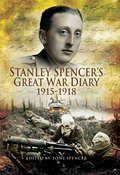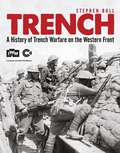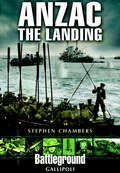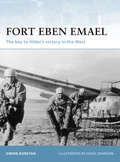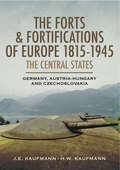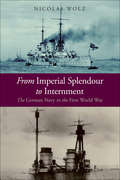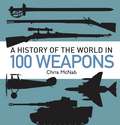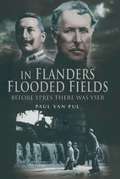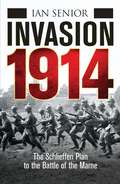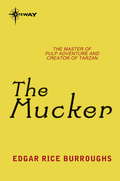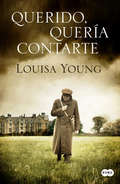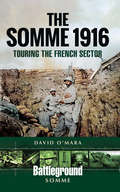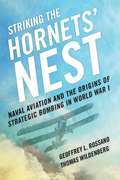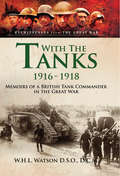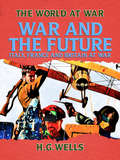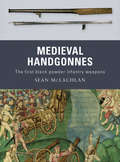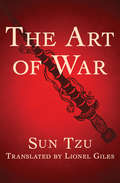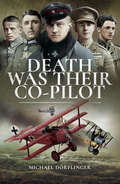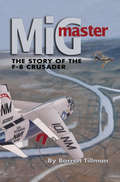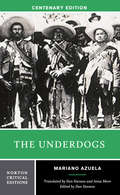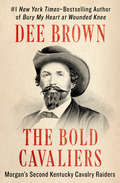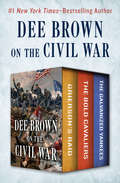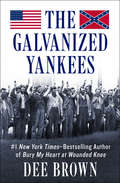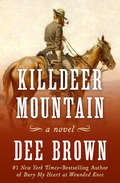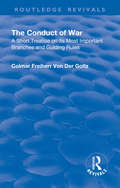- Table View
- List View
Stanley Spencer's Great War Diary, 1915–1918
by Stanley SpencerStanley Spencer enlisted with the Royal Fusiliers as a private in 1915 and was commissioned in 1917 and thereafter served with the West Yorkshire Regiment until demobilised in 1919. He saw almost continuous active service from 1915 to the end of the War.
Trench
by Stephen Bull'Going up Beek trench on a dark night was no picnic. You started along a long narrow alley winding uphill, your hands feeling the slimy sandbag walls, your feet wary for broken duck boards; now and again a hot, stuff smell, a void space in the wall, and the swish of pumped up water under foot proclaimed the entrance to a mine. ... round corners you dived under narrow tunnels two or three feet high, finally emerging into the comparative open of the front line trench.' Soldier, 1/4th Battalion, Loyal North Lancashire Regiment, 1916In this new book, First World War trench expert Stephen Bull provides a complete picture of trench warfare on the Western Front, from the construction of the trenches and their different types, to the new weaponry and tactics employed in defense and attack. In addition, the book describes the experience of life in the trenches, from length of service, dealing with death and disease, to uniforms and discharge. Alongside his compelling narrative of the campaigns fought in the trenches from 1914 to 1918, annotated trench maps highlight particular features of the trenches, while photographs, documents, and first-hand accounts combine to give a full and richly detailed account of war in the trenches.
Anzac–The Landing: Gallipoli (Battleground Gallipoli)
by Stephen ChambersThe Anzac legend was born on the shores of Gallipoli during the historic morning of 25th April 1915. Landing on a hostile beach, under the cover of darkness, the Anzacs moved inland rapidly, but the response of the Ottoman forces was equally quick. The outcome of the campaign was arguably sealed during the first day, when the door for an Anzac victory was closed. With the order to dig, dig, dig and to stick it out, a stalemate was secured from the clutches of almost total disaster. After the Australians and New Zealanders received their baptism of fire, they became a stubborn thorn in the sides of the Ottoman army. Futilely after eight grueling months of fighting, the campaign came to an end with the complete evacuation of the Gallipoli Peninsula.Failure did not mar the actions and sacrifice of the Anzacs who bestowed a powerful legacy, as well as being a landmark in the birth of modern Turkey. Almost a century later, with all the veterans now sadly gone, their legacy still survives in Anzac Day and with the ever increasing numbers of pilgrims who visit the battlefield today.This attractive and well-written book will serve as either a handy guide or concise history (or both).
Fort Eben Emael
by Simon Dunstan Hugh JohnsonAt the outbreak of World War II, Fort Eben Emael in Belgium was the strongest fortress in the world, and it lay exactly across the German invasion route of Belgium and France. The fort's elimination was essential for the success of Hitler's invasion of the West. Deemed impregnable to conventional attack, Hitler himself suggested the means for its capture with the first glider-borne assault in military history. On 10 May 1940, ten gliders carrying just 77 paratroopers landed on top of the fort. Using top-secret hollow-charge weapons for the first time in warfare, the assault pioneers of Sturmgruppe Granit subdued Fort Eben Emael within just 30 minutes, and the fortress surrendered within 30 hours. It remains one of the greatest raids in the annals of Special Forces.
The Forts & Fortifications of Europe 1815-1945: Germany, Austria-Hungry and Czechoslovakia
by J. E. Kaufmann H. W. Kaufmann&“Extremely well written and presented and gives you every scrap of information you&’ll ever need on cupolas, embrasures and cloches.&”—War History Online After the Napoleonic Wars, the borders of Central Europe were redrawn and relative peace endured across the region, but the volatile politics of the late nineteenth century generated an atmosphere of fear and distrust, and it gave rise to a new era of fortress building, and this is the subject of this highly illustrated new study. The authors describe how defensive lines and structures on a massive scale were constructed along national frontiers to deter aggression. The Germans, Austro-Hungarians and Czechs all embarked on ambitious building programs. Artillery positions, barbed-wire networks, casemates, concrete bunkers, trench lines, observation posts all sprang up in a vain attempt to keep the peace and to delay the invader. The strategic thinking that gave rise to these defensive schemes is described in detail in this study, as is the planning, design and construction of the lines themselves. Their operational history in wartime, in particular during the Second World War, is a key element of the account. &“A useful introduction for those wishing to develop a knowledge of fortifications and their impact on the conduct of war.&”—Firetrench &“The maps and plans, especially the plans, are numerous and extremely helpful. They show the arrangement of fortifications in a way that simple text would have found impossible. For those with an interest in European land fortifications of the 19th and 20th centuries, this book is an excellent general survey.&”—The Coast Defense Journal
From Imperial Splendour to Internment: The German Navy in the First World War
by Nicolas WolzThis important new work describes how the Imperial German Navy, which had expanded to become one of the great maritime forces in the world, second only to the Royal Navy, proved, with the exception of its submarines, to be largely ineffective throughout the years of conflict.The impact of this impotence had a far-reaching effect upon the service. Germany, indeed most of Europe, was in the grips of a spirit of militant nationalistic fervour, and the inactivity of the great Imperial Navy caused deep frustration, particularly among the naval officers. Not only were they unable to see themselves as heroes, they were also ridiculed on the home front and felt profoundly humiliated. With the exception of the one sea battle at Jutland, their ships saw little or no action at sea and morale slowly collapsed to a point where, at the end of the war, the crews were in a state of mutiny. The seemingly ludicrous order that forced the fleet to go to sea against the British in 1918 was driven by a sense of humiliation, but coming at the war's end it triggered a revolution because the German sailors wanted no part in such madness. The internment at Scapa Flow was the ultimate shaming. This is a fascinating and perceptive analysis of a whole era, and it contributes substantially to our understanding of the war and its consequences consequences, sadly, that helped pave the way for the Third Reich.
A History of the World in 100 Weapons
by Chris McnabIt's a truism to say that history is written by the winners. But what is it about the winners that make them so powerful? In this enlightening new book, Chris McNab searches for answers to this question and much more, telling the story of the history of the world through the lens of the weapons used over time.Arranged by age, McNab details 100 weapons of history in a highly-illustrated format. Among these 100 weapons: * Roman gladius that helped establish the Roman Empire * Japanese Katana, or Samurai sword * English longbow, used to defeat the French at the battle of Agincourt * Maxim gun * Flying Fortress of World War II - the epitome of US military superiority * bomb on Hiroshima that made a weapon the ultimate deterrent * AK-47 rifle.A History of the World in 100 Weapons presents each weapon in full detail, exploring the how and why of the weapon's development, the times from which it emerged, how it was used in battle and by whom, and to what extent and impact. details of how and why each weapon was invented, the times they emerged from, how they were used in battle.Drawing on stories of famous battles, wars and leaders associated with each weapon, McNab presents a vivid history of the weapons themselves and their context in the development of world history.
In Flanders Flooded Fields: Before Ypres There Was Yser
by Paul Van PulIn October 1914 four armies were converging on Dunkirk. While France was preparing to defend its main Channel port, the Germans were determined to take it while the British were busy using it. Caught in the middle was the Belgian Army. Belgium was almost totally overrun, safe for a small strip of land near the Pas-de-Calais.This is the story of what happened between Antwerp and Dunkirk that fateful month and how the King of the Belgians safeguarded the independence of his small nation from its all-powerful neighbours.Contains 25 custom-made maps, several drawings and 138 seldom seen photographs.
Invasion 1914
by Ian SeniorFor a century, accounts of the German invasion of France and the opening year of the First World War have been dominated by histories of British troops and their experience in battle, despite the fact that the British Expeditionary Force comprised just four divisions, while the French and Germans fielded 60 each. Published to coincide with the 100th anniversary of the outbreak of the Great War, Invasion 1914 examines how the German invasion of France and Belgium came agonizingly close to defeating the French armies, capturing Paris and ending the First World War before the end of the year. Ian Senior reveals how the initial German strategy revolved around, and in part depended on, rapid victory over the French, and how the failure to achieve this resulted in the surprisingly fluid battles of the early days of the war deteriorating into the trench-based warfare which was to see the war drag on for another four years of unprecedented slaughter. Weaving together strategic analysis, diary entries, eyewitness accounts and interview transcripts from soldiers on the ground with consummate skill, this narrative is a timely investigation into the dramatic early months of the war, as the fate of Europe hung in the balance.
The Mucker
by Edgar Rice BurroughsBilly Byrne was a product of the streets and alleys of Chicago's great West Side. From Halsted to Robey, and from Grand Avenue to Lake Street there was scarce a bartender whom Billy knew not by his first name. And, in proportion to their number which was considerably less, he knew the patrolmen and plain clothes men equally as well, but not so pleasantly. His kindergarten education had commenced in an alley back of a feed-store. Here a gang of older boys and men were wont to congregate at such times as they had naught else to occupy their time, and as the bridewell was the only place in which they ever held a job for more than a day or two, they had considerable time to devote to congregating. They were pickpockets and second-story men, made and in the making, and all were muckers, ready to insult the first woman who passed, or pick a quarrel with any stranger who did not appear too burly. By night they plied their real vocations. By day they sat in the alley behind the feedstore and drank beer from a battered tin pail. The question of labor involved in transporting the pail, empty, to the saloon across the street, and returning it, full, to the alley back of the feed-store was solved by the presence of admiring and envious little boys of the neighborhood who hung, wide-eyed and thrilled, about these heroes of their childish lives. Billy Byrne, at six, was rushing the can for this noble band, and incidentally picking up his knowledge of life and the rudiments of his education. By the time he became an adult, he was another thing entirely. . . .
Querido, quería contarte
by Louisa YoungUna historia de amor épica en los horrores de la Primera Guerra Mundial. En el marco de la Primera Guerra Mundial, en escenarios como Londres, París, el condado de Kent o las trincheras del Frente Occidental, Querido, quería contarte es una conmovedora y brillante novela de amor, clases y sexos en tiempos de guerra, y de cómo esta afecta tanto a quienes se quedan en casa como a los que combaten en el frente. Mientras Peter Locke y Riley Purefoy luchan por su país, su supervivencia y su cordura en las trincheras, sus seres queridos hacen lo que pueden en casa. Julia, hermosa y obsesiva, está casada con Peter, tierno y excéntrico. Solo se le ha enseñado a sentirse valorada por su belleza; ¿de qué le vale ahora en ausencia de su amado esposo? Nadine y Riley, con solo dieciocho años cuando comienza la guerra, con tantos sueños que cumplir y obstáculos que vencer, quieren hacer promesas por encima de todo, pero ¿cómo, si el futuro no está en sus manos? Y en cuanto a Rose, prima de Peter, ¿qué ocurrió con las mujeres de educación tradicional que perdieron la esperanza de casarse cuando los jóvenes de su generación se marcharon a la guerra? A medida que la contienda y sus secuelas convierten el sacrificio y el trauma en parte de la cotidianidad, las vidas de estos personajes se entrecruzan de manera inevitable y cambian para siempre. Querido, quería contarte ofrece un testimonio desgarrador de las secuelas físicas y emocionales de la guerra y del poder del amor incondicional. Comentarios:«Una historia de amor épica, una dura crónica de guerra, un estudio de clases, un reconfortante relato de superación. El sello de "obra maestra clásica" figura en cada una de sus páginas. Una elevada y conmovedora historia de tiempos de guerra en la que el amor triunfa sobre la desesperación».Kirkus «Un mes después de leerlo, en mi mente permanece grabado este libro, la nitidez de sus personajes y sus dilemas aun desentrañándose».Linda Grant, autora de La ropa que vestimos «Es una de esas novelas inolvidables, probablemente para siempre. Me llegó tan al fondo del corazón que quise conservar el propio libro cerca, como si pudiese confortar a los personajes y aferrarme con fuerza a ellos».Jacqueline Winspear, autora de Maisie Dobbs, investigadora privada: el caso de los soldados sin nombre «Un héroe y una heroína irresistibles son el alma. La transformación de sus vidas -en sentido literal y figurado- a raíz de la Primera Guerra Mundial articula una sorprendente novela de suspense y ternura. Me ha cautivado».Margot Livesey, autora de Un mundo de olvido «Tan terrorífica como brillante [...]. Te transporta por uno de los pasajes más oscuros de la experiencia humana y te mantiene agarrado hasta que emerges, profundamente enriquecido, en la otra orilla. Me quedé embelesada desde la primerapágina hasta la última. Con su exquisito y ágil estilo, Young ha recreado un mundo en guerra y le ha dado vida a las silentes caras que yo creía conocer tan bien. Qué equivocada estaba».Anne Fortier, autora de Juliet «Maravillosa».The Times «Convincente y profundamente conmovedora».The Observer «Ha sabido captar el espíritu de la Primera Guerra Mundial de un modo extraordinario [...]. Esta novela es un triunfo».Elizabeth Jane Howard, autora de Igual que el mar «Un relato de amor y pérdida en los horrores de la Primera Guerra Mundial con un hilo narrativo magistral».Psychologies Magazine «Una narradora magistral».The Washington Post
The Somme 1916: Touring the French Sector (Battleground Somme)
by David O'MaraWith a few notable exceptions, the French efforts on the Somme have been largely missing or minimized in British accounts of the Battle of the Somme. And yet they held this sector of the Front from the outbreak of the war until well into 1915 and, indeed, in parts into 1916. It does not hurt to be reminded that the French army suffered some 200,000 casualties in the 1916 offensive.David OMaras book provides an outline narrative describing the arrival of the war on the Somme and some of the notable and quite fierce actions that took place that autumn and, indeed, into December of 1914. Extensive mine warfare was a feature of 1915 and beyond on the Somme; for example under Redan Ridge and before Dompierre and Fay. The French limited offensive at Serre in June 1915 is reasonably well known, but there was fighting elsewhere for example the Germans launched a short, sharp, limited attack at Frise in January 1916, part of the diversionary action before the Germans launched their ill-fated offensive at Verdun.The book covers the Somme front from Gommecourt, north of the Somme, to Chaulnes, at the southern end of the battle zone of 1916. The reader is taken around key points in various tours. For many British visitors the battlefields south of the Somme will be a revelation; there is much to see, both of cemeteries and memorials, but also substantial traces of the fighting remain on the ground, some of which is accessible to the public.It has always been something of a disgrace that there is so little available, even in French, to educate the public in an accessible written form about the substantial effort made by Frances army on the Somme; this book and subsequent, more detailed volumes to be published in the coming years will go some way to rectify this. British visitors should be fascinated by the story of these forgotten men of France and the largely unknown part of the Somme battlefield.
Striking The Hornets' Nest: Naval Aviation And The Origins Of Strategic Bombing In World War I
by Geoffrey L. Rossano Thomas WildenbergStriking the Hornets’ Nest provides the first extensive analysis of the Northern Bombing Group (NBG), the Navy’s most innovative aviation initiative of World War I and one of the world’s first dedicated strategic bombing programs. Very little has been written about the Navy’s aviation activities in World War I and even less on the NBG. Standard studies of strategic bombing tend to focus on developments in the Royal Air Force or the U. S. Army Air Service. This work concentrates on the origins of strategic bombing in World War I, and the influence this phenomenon had on the Navy’s future use of the airplane. The NBG program faced enormous logistical and personnel challenges. Demands for aircraft, facilities, and personnel were daunting, and shipping shortages added to the seemingly endless delays in implementing the program. Despite the impediments, the Navy (and Marine Corps) triumphed over organizational hurdles and established a series of bases and depots in northern France and southern England in the late summer and early fall of 1918. Ironically, by the time the Navy was ready to commence bombing missions, the German retreat had caused abandonment of the submarine bases the NBG had been created to attack. The men involved in this program were pioneers, overcoming major obstacles only to find they were no longer needed. Though the Navy rapidly abandoned its use of strategic bombing after World War I, their brief experimentation directed the future use of aircraft in other branches of the armed forces. It is no coincidence that Robert Lovett, the young Navy reserve officer who developed much of the NBG program in 1918, spent the entire period of World War II as Assistant Secretary of War for Air where he played a crucial role organizing and equipping the strategic bombing campaign unleashed against Germany and Japan. Rossano and Wildenberg have provided a definitive study of the NBG, a subject that has been overlooked for too long.
With the Tanks, 1916–1918: Memoirs of a British Tank Commander in the Great War (Eyewitnesses from The Great War)
by W.H.L. WatsonWilliam Watson was a young Oxford post-graduate at the outbreak of the First World War in 1914. Along with several friends from Oxford he enlisted in the army expecting the war to last six weeks. Watson began his service in the Great War as a British Army motorcycle despatch rider. He saw active service during the key battles of 1914 and early 1915. Watson was then commissioned and became a tank commander and saw active service with the tanks most notably at Cambrai in 1917. This well written and evocative memoir was originally published under the tile 'A Company Of Tanks' it constitutes a wonderful primary source and is an invaluable addition to the library of anyone with an interest in the evolution of the tank as a decisive weapon on the battlefield. Highly detailed, but nonetheless accessible this superb new illustrated edition, edited by Emmy AwardTM winning historian Bob Carruthers is greatly recommended for serious enthusiasts and casual readers alike.
War and the Future: Italy, France And Britain At War (The World At War)
by H. G. WellsExcerpt: "One of the minor peculiarities of this unprecedented war is the Tour of the Front. After some months of suppressed information—in which even the war correspondent was discouraged to the point of elimination—it was discovered on both sides that this was a struggle in which Opinion was playing a larger and more important part than it had ever done before. This wild spreading weed was perhaps of decisive importance; the Germans at any rate were attempting to make it a cultivated flower. There was Opinion flowering away at home, feeding rankly on rumour; Opinion in neutral countries; Opinion getting into great tangles of misunderstanding and incorrect valuation between the Allies. The confidence and courage of the enemy; the amiability and assistance of the neutral; the zeal, sacrifice, and serenity of the home population; all were affected. The German cultivation of opinion began long before the war; it is still the most systematic and, because of the psychological ineptitude of the Germans, it is probably the clumsiest. The French Maison de la Presse is certainly the best organisation in existence for making things clear, counteracting hostile suggestion, the British official organisations are comparatively ineffective; but what is lacking officially is very largely made up for by the good will and generous efforts of the English and American press. An interesting monograph might be written upon these various attempts of the belligerents to get themselves and their proceedings explained."
Medieval Handgonnes
by Gerry Embleton Sean MclachlanOsprey's new Weapon series provides a highly-detailed yet affordable overview of the development, use, and impact of small arms throughout history--from the sword to the machine gun. Journey back to the time when handguns had no moving parts! Variously called handgonnes, hackbuts, coulevrines, pistolas, schiopettos, tyufyaks, and even bombardelles, the first black powder infantry weapons were extremely crude by today's standards. In his new book, Sean McLachlan, author of American Civil War Guerilla Tactics, dispels the myth that these weapons were ineffective on the battlefield (beyond their terrifying noise!). Rather, he demonstrates through careful examination of the historical records that the handgonne was a viable weapon from its inception, even as it saw action side-by-side with the cross-bow.Readers will be treated to a lush collection of rare photographs and artwork from such far-flung locales as Danish National Museum and the Bayerisches Armeemuseum. Original artwork from Gerry and Sam Embleton illustrate how these weapons were used on the battlefield and reenactor photos demonstrate step-by-step how they were loaded and fired.
The Art of War: The Essential Translation Of The Classic Book Of Life (Penguin Modern Classics Series #909)
by Sun TzuThe world&’s most influential treatise on strategy Mao Zedong used it to defeat Chiang Kai-shek. Colin Powell thinks every US soldier should be familiar with its principles. New England Patriots coach Bill Belichick built a football dynasty out of lessons learned within its pages. Even Gordon Gekko and Tony Soprano are fans. In the twenty-five hundred years since it was composed, The Art of War has been applied to just about every field of human endeavor. Sun Tzu&’s shrewd advice is indispensible to anyone seeking to gain an advantage over an opponent.
Death Was Their Co-Pilot: Aces of the Skies
by Michael DorflingerIt was in World War I that the skies first became a battlefield, with nations seeking to decide military outcomes off the ground. This volume introduces the fighter pilots of World War I, including the infamous Red Baron Manfred von Richthofen. In addition to this iconic flying ace, the author presents the thrilling biographies of numerous others and recounts their exploits and the tragedies they suffered. Likewise, the book illustrates the Great Wars historical background and documents the increasing sophistication of aviation technology and warfare.
MiG Master
by Barrett TillmanTo be equally enjoyed by professional aviators and aviation buffs with limited technical knowledge, this biography brings to life the legendary aircraft that scored the highest kill ratio of any U.S. fighter aircraft in the Vietnam War. The book is filled with authentic re-creations of Crusader-MiG fights and vivid descriptions of the people and events that are part of the F-8 story, including John Glenn's 1957 record-breaking flight across the United States in three hours and twenty-three minutes. As the Navy's first supersonic aircraft, the Crusader holds an honored spot in carrier flying, and the author shows why it is called one of the most capable, versatile, and long-lived aircraft in naval aviation history. Barrett Tillman effectively combines an exciting account of the F-8's operational history with a detailed and authoritative explanation of its design, construction, and modifications. Tillman recalls the years of frustration and experimentation spent in refining the aircraft and its gunnery system, and then takes the reader through key actions in Vietnam where seasoned pilots handled their "rambunctious steeds" with scarcely a glance in the cockpit. Extensive appendixes provide further details.
The Underdogs
by Mariano AzuelaLos de abajo (The Underdogs) is Mariano Azuela's unforgettable novel of the Mexican Revolution (1910-17). It is widely regarded as the best Mexican novel about the war and was published during the armed struggle. This Norton Critical Edition is based on a new translation by acclaimed scholars Ilan Stavans and Anna More. It is accompanied by Stavans' introduction and explanatory footnotes. Numerous artists and intellectuals have commented on The Underdogs, and the Norton Critical Edition includes a judicious selection of these comments to help place the novel in its historical context. The eyewitness account of John Reed is joined by the assessments of Anita Brenner and Octavio Paz. A 1994 letter by Subcomandante Marcos to Mexico's then-president Ernesto Zedillo points to the Mexican Revolution as an unfinished event, one that brought little relief to large segments of the country's population. Five wide-ranging critical assessments of Mariano Azuela and The Underdogs are provided by Waldo Frank, Harriet de On#65533;s, Luis Leal, Ilan Stavans, and Clive Griffin. A selected bibliography is also included.
The Bold Cavaliers: Morgan's Second Kentucky Cavalry Raiders
by Dee BrownA thrilling Civil War history of Morgan's Raiders, the Confederate cavalrymen who spread terror through the NorthIn this vibrant and thoroughly researched Civil War study, Dee Brown tells the story of Morgan's Raiders, the Kentucky cavalrymen famed and feared for their attacks on the North. In 1861, Brigadier General John Hunt Morgan and his brother-in-law Basil Duke put together a group of formidable horsemen, and set to violent work. They began in their home state, staging raids, recruiting new soldiers, and intercepting Union telegraphs. Most were imprisoned after unsuccessful incursions into Ohio and Indiana years later, but some Raiders would escape, regroup, and fight again in different conflicts, participating in the so-called Great Conspiracy in Canada. The Bold Cavaliers is as engrossing in its historical detail as in its rich adventure. This ebook features an illustrated biography of Dee Brown including rare photos from the author's personal collection.
Dee Brown on the Civil War: Grierson's Raid, The Bold Cavaliers, and The Galvanized Yankees
by Dee BrownThree true tales of Civil War combat, as recounted by a #1 New York Times–bestselling author of Bury My Heart at Wounded Knee. The acclaimed historian of the American West turns his attention to the country’s bloody civil conflict, chronicling the exploits of extraordinary soldiers who served in unexpected ways at a pivotal moment in the nation’s history. Grierson’s Raid: The definitive work on one of the most astonishing missions of the Civil War’s early days. For two weeks in the spring of 1862, Col. Benjamin Grierson, a former music teacher, led 1,700 Union cavalry troops on a raid from Tennessee to Louisiana. The improbably successful mission diverted Confederate attention from Grant’s crossing of the Mississippi and set the stage for the Siege of Vicksburg. General Sherman called it “the most brilliant expedition of the war.” The Bold Cavaliers: In 1861, Brig. Gen. John Hunt Morgan and his brother-in-law Basil Duke put together a group of formidable horsemen, and set to violent work. Morgan’s Raiders began in their home state, staging attacks, recruiting new soldiers, and intercepting Union telegraphs. Most were imprisoned after unsuccessful incursions into Ohio and Indiana years later, but some Raiders would escape, regroup, and fight again in different conflicts. “Accurate and frequently exciting” (Kirkus Reviews). The Galvanized Yankees: The little-known and awe-inspiring true story of a group of captured Confederate soldiers who chose to serve in the Union Army rather than endure the grim conditions of prisoner of war camps. “An accurate, interesting, and sometimes thrilling account of an unusual group of men who rendered a valuable service to the nation in a time of great need” (The New York Times Book Review).
The Galvanized Yankees: Grierson's Raid, The Bold Cavaliers, And The Galvanized Yankees
by Dee BrownThe awe-inspiring true story of a group of Confederate soldiers who served in the Union ArmyHistorian Dee Brown uncovers an exciting episode in American history: During the Civil War, a group of Confederate soldiers opted to assist the Union Army rather than endure the grim conditions of POW camps. Regiments containing former Confederates were not trusted to go into battle against their former comrades, and instead were sent to the West as "outpost guardians," where they performed frontier duties, including escorting supply trains, rebuilding telegraph lines, and quelling uprisings from regional American Indian tribes, which were sweeping across the Plains. This is an account of an extraordinary, though often overlooked, group of men who served in unexpected ways at a pivotal moment in the nation's history. This ebook features an illustrated biography of Dee Brown including rare photos from the author's personal collection.
Killdeer Mountain: A Novel
by Dee BrownAn intrepid reporter's investigation into the death of a controversial major reveals a surprising story of betrayal and redemptionIt is 1866, and Sam Morrison, reporter for the St. Louis Herald, is aboard a steamer bound for Fort Standish off the coast of Massachusetts, determined to solve a mystery. The fort is about to be renamed in honor of Charles Rawley, a major who recently died in a fire while trying to prevent the escape of a captured Sioux chief. But just who was Rawley? Morrison is told a dizzying host of tales about the man--some call him a despot but others describe him as a martyr. He was a man all too willing to execute a deserter, but one who would spur his troops to do the utmost to ensure the safety of women and children. As the investigation unfolds, Morrison doesn't know which stories to believe--especially when it comes to the truth about Rawley's death. Thrilling and wily, Killdeer Mountain is a deft triumph of historical fiction. This ebook features an illustrated biography of Dee Brown including rare photos from the author's personal collection.
Revival: A Short Treatise on its Most Importsant Branches and Guiding Rules (Routledge Revivals)
by Colmar Freiherr von de GoltzThis book contains, in a brief form, author’s views a to the conduct of the principal strategical and tactical operations of war, and will be found to be a short and convenient introduction to a deeper study of the rules which should underlie the direction of the ever-varying incidents of modern fighting.
